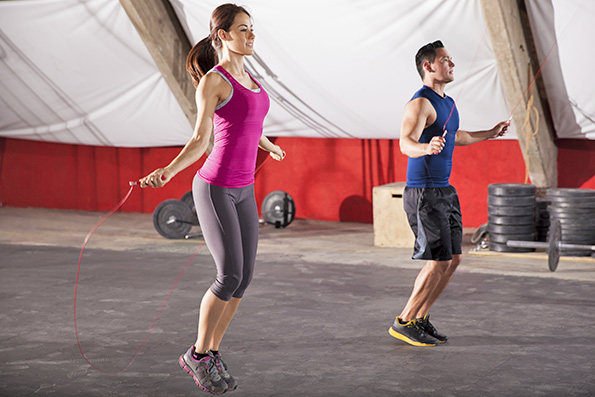

How high-intensity interval training (HIIT) can help you get fit quicker (via @deliciousliving)
Looking for a fast, effective way to get in shape? (Aren’t we all?) A growing body of research supports high-intensity interval training (HIIT) as an effective way to maximize fat loss in minimal time. Trendy workouts such as CrossFit, Insanity, and P90X are all variations on HIIT, which alternates short, intense exercise bursts with rest periods.
HIIT claimed the top spot on the American College of Sports Medicine’s 2014 list of fitness trends, and Insanity and CrossFit were the two most Googled workouts of 2013. Athletes and college students have long favored HIIT workouts, but more newbies are jumping on the HIIT wagon, says Jason Organ, HIIT FIT director at Edgewater Athletic Club in Chicago. The intense aspect of these workouts can make them intimidating at first, he says. “A lot of people say, ‘I don’t know if I can do that.’ When they actually get into it, their confidence almost goes through the roof.”
Still, injury concerns make many fitness enthusiasts wary of some HIIT programs. Find out what the buzz is about and whether HIIT might be right for you.
The workout
With HIIT, you perform all-out bursts—we’re talking 100 percent effort—of anaerobic exercise (squats, sprints, jumping jacks) followed by short rests; this raises your heart rate, burns fat, and boosts metabolism so your body continues to burn fat even after your workout is done. A starter workout might be a one-minute sprint followed by two minutes of walking, repeated five times within 15 minutes. HIIT workouts typically use minimal equipment, so you can do them anywhere.
CrossFit includes HIIT but usually adds weights and gymnastic moves. “The National Strength and Conditioning Association [NSCA] calls CrossFit high-intensity power training because it often includes deadlifts, overhead presses, and headstand push-ups,” says Pamela Kufahl, director of content and engagement for Club Industry (a Penton publication).
Cautions
HIIT’s main drawback: It’s easy to hurt yourself. Speed, intensity, and repetition (plus too little instruction) can lead to bad form, which raises injury risk significantly. With CrossFit in particular, “workouts of the day” are often timed group competitions that tempt people to take shortcuts.
In November 2013, the NSCA published a study in the Journal of Strength and Conditioning Research in which researchers examined 54 CrossFit participants who engaged in a ten-week challenge. According to the authors, 11 participants dropped out of the program, 9 of them because of “overuse or injury.” CrossFit filed suit against NSCA, stating “the report of a 16 percent ‘overuse or injury’ rate is at best the result of sloppy and scienti-fically unreliable work, and at worst a complete fabrication.” The NSCA plans to “vigorously defend” its report.
Be smart, be safe
Always, when you start a new exercise program, check with your health care provider first to get personalized advice.
If your workout routine leads to injury—even a mild one—stop. Workouts may well push you and even make you sore the next day, but pain isn’t the goal. Arguably, the best exercise approaches incorporate both anaerobic, high-intensity intervals and gentler, “steady state” aerobic exercise like walking or jogging.
If you decide to try HIIT, look for a club and trainer that emphasize the importance of safety and technique—and start with a beginner’s class, where you’ll get special attention before integrating into regular classes. Many fitness clubs now offer small-group HIIT classes to meet demand. “[HIIT] just fits the way the world is,” says Sara Kooperman, CEO of Les Mills Midwest and founder and CEO of SCW Mania conventions. “One of the biggest barriers is simply people finding the time [to exercise]. If you can make it shorter, faster, harder, then that’s what people like.”
More top fitness moves
Body-weight training. Strength exercises that use your body weight rather than equipment (for example, push-ups, pull-ups, squats, lunges). Great for most people regardless of ability or experience.
Strength training. Exercises typically use weight machines or free weights (dumbbells, barbells). Machines target one to two muscle areas.
Personal training. A fitness expert works with you one-on-one to tailor a workout program for your goals.
Functional fitness. Strength exercises mimic everyday activities to train the body to perform them without injury; improves balance and ease of daily living.
Source: American College of Sports Medicine.
